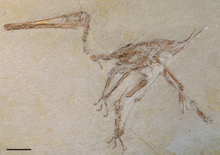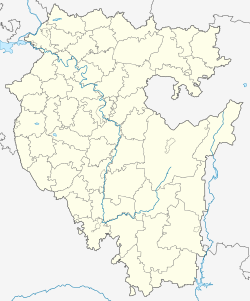모룰라
Morula| 모룰라 | |
|---|---|
 폭발 1 - 모룰라, 2 - 모룰라 | |
 | |
| 세부 사항 | |
| 날들 | 3 |
| 전구체 | 지고테 |
| 낳다 | 블라큘라, 블라스토시스트 |
| 식별자 | |
| 메슈 | D009028 |
| TE | E2.0.1.2.0.0.11 |
| 해부학적 용어 | |
모룰라(라틴어, morus: 뽕나무)는 조나 펠루치다 안에 들어 있는 고체 공 안에 있는 16개의 세포(블라토메레스라고 한다)로 구성된 초기 단계의 배아다.[1][2]
모룰라는 모룰라(수정 후 3~4일)가 구형의 16개의 만능세포 덩어리가 되는 반면, 배반포시스트(수정 후 4~5일)는 내부 세포 덩어리와 함께 조나 펠루치다 내부에 충치가 있다는 점에서 배반포시와 구별된다. 모룰라는 손대지 않고 계속 이식될 수 있다면 결국 배반포구로 발전할 것이다.[3]
모굴라는 단세포 지고테(cytula)를 시작으로 초기 배아의 일련의 갈라진 분열에 의해 생성된다. 일단 배아가 16개의 세포로 나뉘면 뽕나무와 닮기 시작하는데, 따라서 morula(라틴어, morus: 뽕나무)라는 이름이 붙는다.[4] 수정 후 며칠 안에 모굴라의 바깥쪽에 있는 세포들이 데스모솜과 갭 접합체의 형성과 함께 단단하게 결합되어 거의 분간할 수 없게 된다. 이 과정은 압축이라고 알려져 있다.[5][6] 외부와 내부의 세포는 영양성분과 내부 세포질량(내부)의 생성자로 차등화된다. 영양성분 세포에서 나트륨 이온의 활발한 운반과 물의 삼투에 의해 모울라 내부에서 충치가 형성된다. 이것은 배반포구로 알려진 속이 빈 세포 덩어리를 만들어낸다.[7][8] 배반포체의 외부 세포는 최초의 배아 상피가 될 것이다. 그러나 일부 세포는 내부에 갇혀서 내부 세포질량(ICM)이 될 것이며 전능하다. 포유류(단조류 제외)의 경우 ICM은 궁극적으로 '전방적정체'를 형성하고, 대류핵은 태반과 외전조직(exter-embronic tissue)을 형성하게 된다. 그러나 파충류는 ICM이 다르다. 무대가 길어지고 네 부분으로 나뉜다.[9][10][11][12]
참고 항목
참조
- ^ Boklage, Charles E. (2009). How New Humans Are Made: Cells and Embryos, Twins and Chimeras, Left and Right, Mind/Self/Soul, Sex, and Schizophrenia. World Scientific. p. 217. ISBN 9789812835130.
- ^ "The Early Embryology of the Chick". UNSW Embryology. Retrieved 2015-03-03.
- ^ "The Morula and Blastocyst". the Endowment for Human Development. Retrieved 11 April 2015.
- ^ Sherman, Lawrence S.; et al., eds. (2001). Human embryology (3rd ed.). Elsevier Health Sciences. p. 20. ISBN 978-0-443-06583-5.
- ^ Chard, Tim & Lilford, Richard (1995). Basic sciences for obstetrics and gynaecology. Springer. p. 18. ISBN 978-3-540-19903-8.
{{cite book}}: CS1 maint: 작성자 매개변수 사용(링크) - ^ Mercader, Amparo et al. (2008). "Human embryo culture". In Lanza, Robert; Klimanskaya, Irina (eds.). Essential stem cell methods. Academic Press. p. 343. ISBN 978-0-12-374741-9.
{{cite book}}: CS1 maint: 작성자 매개변수 사용(링크) - ^ Patestas, Maria Antoniou & Gartner, Leslie P. (2006). A textbook of neuroanatomy. Wiley-Blackwell. p. 11. ISBN 978-1-4051-0340-4.
- ^ Geisert, R.D.; Malayer, J.R. (2000). "Implantation: Blastocyst formation". In Hafez, B.; Hafez, Elsayed S.E. (eds.). Reproduction in farm animals. Wiley-Blackwell. p. 118. ISBN 978-0-683-30577-7.
- ^ Morali, Olivier G. et al. (2005). "Epithelium-Mesenchyme Transitions are Crucial Morphogenetic Events Occurring During Early Development". In Savagner, Pierre (ed.). Rise and fall of epithelial phenotype: concepts of epithelial-mesenchymal transition. Springer. p. 16. ISBN 978-0-306-48239-7.
{{cite book}}: CS1 maint: 작성자 매개변수 사용(링크) - ^ Birchmeier, Carmen; et al. (1997). "Morphogenesis of epithelial cells". In Paul, Leendert C.; Issekutz, Thomas B. (eds.). Adhesion molecules in health and disease. CRC Press. p. 208. ISBN 978-0-8247-9824-6.
- ^ Nagy, András (2003). Manipulating the mouse embryo: a laboratory manual. CSHL Press. pp. 60–61. ISBN 978-0-87969-591-0.
- ^ Connell, R.J.; Cutner, A. (2001). "Basic Embryology". In Cardozo, Linda; Staskin, David (eds.). Textbook of female urology and urogynaecology. Taylor & Francis. p. 92. ISBN 978-1-901865-05-9.


